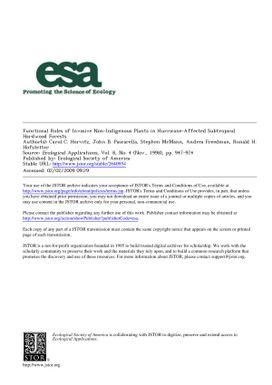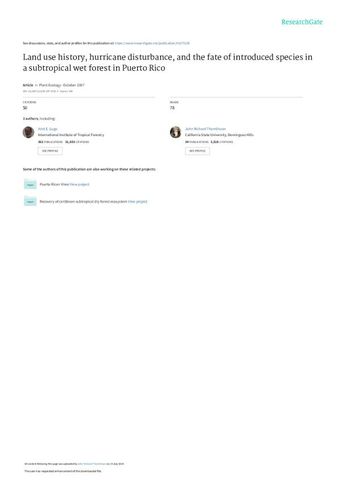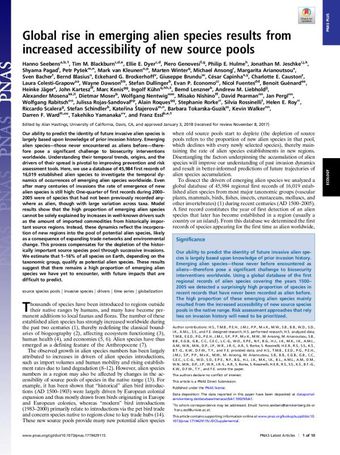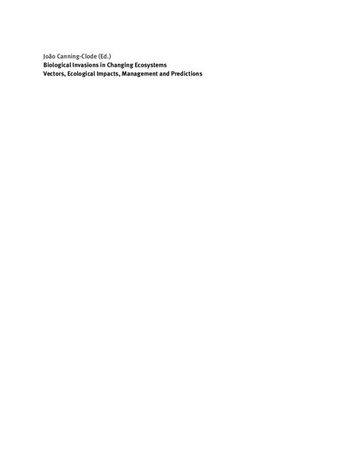Funtional Roles of Invasive Non-indigenous Plants in Hurricane-Affected Subtropical Hardwood Forests
- Description:
- Native forest species exhibit a well-known range of ecological roles with respect to natural disturbance regimes, from pioneer phase to mature phase, and they regenerate from a range of sources, including dormant seeds, seed rain, pre-established juveniles, and resprouts from damaged adults. In contrast, the ecological roles of invasive, non-indigenous species in forest communities after natural disturbances are not well understood. Some previous studies of invasive species have emphasized their weedy nature and their ability to colonize anthropogenic disturbances. Tropical hardwood hammock forest in southern Florida experience frequent disturbance by hurricanes. Our studies of forest regneration during two years following a recent severe hurricane suggest that invasive non-indigenous forest species exhibit the same range of ecological roles as native forest regeneration during two years following a recent severe hurricane suggest that invasive non-indigenous forest species exhibit the same range of ecological roles as native forest species and compete with native species for particular kinds of regeneration opportunities. To study ecological roles of non-indegenous species in regenerating forests after Hurricane Andrew, we set up four large study areas at each of three study sites that had differing amounts of hurricane-caused canopy disturbance. There were two pairs of 30 X 60 m research plots per site, and in each pair there was one control plot and one restoration plot; restoration areas were subject to an aggressive management program, focused on reducing non-indigenous vine cover. Within these study areas we subsampled vegetation in small study plots that were regularly spaced, and conducted vegetation censuses in April (the end of the dry season) and October (the end of the rainy season) for 2 yr, beginning in April 1993. We found that the source of regeneration for forest species was dependent upon the amount of canopy disturbance, the time since disturbance, and the autecology of the constituent species. Overall, 28% of the 90 species were non-indigenous: 34% of the vines (N=32) and 24% of other life-forms (N=58). Non-indigenous vines seemed to have a special role; not only could they compete with native vines, but they could also negatively affect the regeneration of other natives from a diverse array of sources including pre-established juveniles and resprouts from damaged adults. Both native and non-indigenous vine cover in unmanipulated study areas increased following the hurricane. Non-indigenous vine species had higher cover than native vine species, and many species formed dense "blankets." Non-indigenous species in general (not just vines) did not differ significantly from native species in seed mass, nor were they restricted to the pioneer type of life history. Many non-indigneous species had invaded forests prior to hurricane disturbance and had their own banks of pre-established juveniles; others recruited from dormant seeds, and seed rain, and/or respouts from pre-established adults. Based on information on source of regeneration and impact on native species, we propose a classification scheme for functional roles of non-indigenous invasive species in forests. To investigate whether non-indigenous taxa had roles in other geographic regions similar to those they had in Florida, we reviewed literature for 50 taxa belonging to genera that have species known to be invasive in southern Florida. We found that these taxa were invsive or had cogeners that were invsive in other geographic regions (Western Australis, the Mariana Islands, Hawaii, the rMascarene Islands, and South Africa). We propose that taxa predominantly retain their invasive, functional-role type across regions. Thus, studies of ecological roles of invasive species with respect to natural disturbance regimes in one region may help us predict invasive roles in other regions.
- Display date:
- 1998
- Collections:
- Secretariat of the Pacific Regional Environment Programme (SPREP)
- Content partner:
- Secretariat of the Pacific Regional Environment Programme (SPREP)
- Availability:
- Not specified
-
Copyright status: All rights reservedFind out more about what you are able to do with this itemThis item is all rights reserved, with means you'll have to get permission from Secretariat of the Pacific Regional Environment Programme (SPREP) before using it. For more information, please see our use and reuse page.What can I do with this item?Non-infringing useNZ copyright law does not prevent every use of a copyright work, and this item may be hosted by an international institute or organisation. You should consider what you can and cannot do with a copyright work.No sharingYou may not copy and/or share this item with others without further permission. This includes posting it on your blog, using it in a presentation, or any other public use.No modifyingYou are not allowed to adapt or remix this item into any other works.No commercial useYou may not use this item commercially.
Related items
Welcome and warm Pasifik greetings
The information on this site has been gathered from our content partners.
The names, terms, and labels that we present on the site may contain images or voices of deceased persons and may also reflect the bias, norms, and perspective of the period of time in which they were created. We accept that these may not be appropriate today.
If you have any concerns or questions about an item, please contact us.



